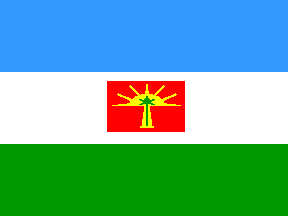
by Guillermo Aveledo, 4 august 2000

Last modified: 2005-06-17 by dov gutterman
Keywords: barinas | venezuela | sabana | spike | palm | coffee | tobacco | sword | lance | phrygian cap | bull | laurel | sun |
Links: FOTW homepage |
search |
disclaimer and copyright |
write us |
mirrors

by Guillermo Aveledo, 4 august 2000
See also:
Municipalities (Capitals):
Other Sites:
Barinas is a western state of Venezuela and its name is based
on one of its principal rivers. The barinensian flag is divided
in three horizontal stripes with the same size. The sky-blue
(above) represents a bright sky and the people's hope . The white
(center) reminds the immensity and the mist of the Andes mountain
foot. The green (below) symbolizes the "sabana" (the
plain): the predominant landscape of the region. In the center
appears a reclined red rectangle which represents the regional
history, the warrior past of the state, the burned faces by the
fire and the blood leaked for the Independence. Inside of the
rectangle we can appreciates a yellow shining sun which reminds
the emblematical color of the Liberal Party in the "War of
the Federation" (1859-1863) a Venezuelan Civil War in the
19th Century and besides the Battle of Santa Ine's (December
10th, 1859) won by the troops under the command of General
Ezequiel Zamora, leader of the liberal cause. The seven sunrays
symbolize the seven provinces, which declared the Independence of
Venezuela in July 5th, 1811: Barinas was one of them. The yellow
truncated triangle represents the way oriented to the encounter
with the sun and the union of both symbolical elements, reminds a
spike of grain how the presence of the ground signing the
development and highness of one people. The green palm tree
represents the symbolical ecology of the state because this plant
has a special presence in the oral and written literature of the
region. All this symbols, in conjunction, reminds the
"Camino de Palma y Sol"(The Palm and Sun's Way), phrase
which appears in the song Linda Barinas: the second regional
anthem. This flag, product of a concourse called "Una
Bandera para Barinas" (One Flag for Barinas) won by Mr.
Fernando Daniel Perez Castellano (he has only ten years old when
he took part in the competition) and the Barinensian
Singer-Author Mr. Guillermo Jimenez Leal, was granted by the
Legislative Assembly of the Barinas State by means of the Decree
104-97 in December 10, 1997.
With regards to the Coat of Arms of this
Venezuelan state, it is divided per pale and fess. The first
quarter in Or (yellow) charges a coffee and a tobacco branches
jointed under a golden caduceus representing the commerce of
these plants, the most important agricultural products for
exportation in the state. The second quarter in gules (red) shows
two swords and two pavilions crossed with a lance crowned by the
Phrygian cap, symbol of the Republic, for represent the glorious
trophies conquered by the heroism and sacrifice of the
barinensians in the Independence War of Venezuela. The third
quarter shows a landscape with a bull, reminding the
cattle-rising richness of the state, looking to a river which
born at the Andes mountain foot and running on the plains, after
fertilizes the forest. In the center of the shield we can see a
golden bar charging the motto "DIOS Y FEDERACION" (God
and Federation) which was the war cry of the liberal party in the
Venezuelan Federation War. The cimier consist in a shining sun
representing the glory, which charges the war voice "SANTA
INES 10 DE DICIEMBRE DE 1859" reminds the Battle of Santa
Ines and its date, previously mentioned, one of the most
important triumphs in the Venezuelan Federation War. The seven
stars over the sun are symbols of the earlier seven districts of
the Barinas State. A yellow pennant joints the laurel crown,
symbol of victory.
Raul Jesus Orta Pardo, 1 August 2000
Raul wrote: "In the center appears a reclined red
rectangle". What does "reclined" mean?
Guillermo Aveledo, 4 august 2000
I think it probably means that the rectangle is lying down,
that is, its long dimension is horizontal.
John Ayer, 4 august 2000
barin.gif)
by Raul Jesus Orta Pardo, 1 August 2000